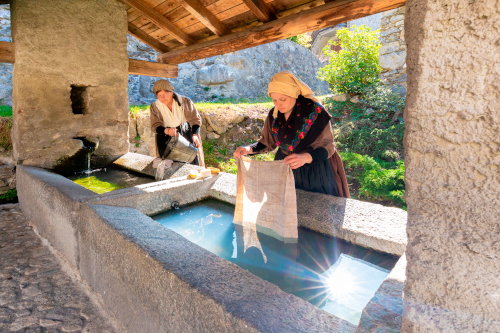Scattered
across the whole province, you’ll find historic shelters, homes and habitable hideaways
that bear witness to centuries past and demonstrate our great ability to adapt
to conditions and turn them in our favour. Here are Valtellina’s pieces of
must-see rural architecture.
THE LITTLE HUTS – BAITEI – OF SERNIO
.Just outside of Tirano sits a
small rural village called Sernio, where its “baitei” are a surprising tourist gem – see
here for more info. Created by the smart-thinking population, these circular,
dome-shaped constructions are believed to go back to the 15th century
BC and served the purpose of providing shelter,
conserving food, and offering storage for tools.
Well preserved over recent decades, a visit to Sernio and its little
collection of baitei opens your eyes to a charming part of local
history, where people lived and retreated.
DRY-STONE WALLS ACROSS VALTELLINA
In this steep-sided valley,
more than 2,500 km of dry-stone walls are tangible proof of how much wine
production and crop-growing has taken place over the years. Lining the Rhaetian
Alps side of the province, these terraces have enabled the population to grow
and harvest grapes on the steep gradients for generations—an activity that
still flourishes today. This functional art form has been recognised globally
and declared an Intangible Cultural Heritage by UNESCO.
VALTELLINA’S MILLS
The historic Mulino Menaglio in Teglio is one of Valtellina’s finest water mills,
having been carefully restored by local associations. While no longer
operational, the mill in San Rocco whisks visitors back in time with genuine
artefacts and exhibition spaces that tell the story of buckwheat, rye and other
flour production.
Up in Aprica, the Mulino dei
Plaz is in the process of being restored. As a museum it
recounts how the locals carried out the milling of ancient grains grown here in
the mountains. Elsewhere, take a walk in the woods around Castello dell’Acqua
to take in the restored former mill and mortar in Cà dell’Albert, which is open to tourists and educational groups.
Bormio’s Mulino Salacrist, which now houses an exhibition
space, is a must for anyone with an interest in medieval milling techniques.
SONDRIO’S HISTORIC SCARPATETTI NEIGHBOURHOOD
The old worker’s neighbourhood
of Scarpatetti in Sondrio is viewable in a short walk across the town, taking
in beautifully preserved wooden features on rural homes decorated with coats of
arms, lamps and flowers to create a truly Instagrammable district.
VISITING THE CROTTI IN VALCHIAVENNA
The Crotti in Valchiavenna are age-old natural caves that benefit from a natural breeze known as
‘sorel’. This daily wind has long ensured a consistent temperature all year to
best preserve the area’s wine, meat and cheese. Now part of Valchiavenna’s
social fabric, the crotti are where you’ll go to tap into a connection with the
finest food and wine from the region. Each September there’s a festival
dedicated to the Crotti and other local traditions. See more here: https://www.sagradeicrotti.it/what-is-crotto/
THE CALÈCC OF VALGEROLA
In the mountainous valley
behind Morbegno, Valgerola is home to “calècc”, which are the area’s
signature-style shelters that have long existed on high-altitude meadows for
preparing the iconic local Bitto cheese over a fire. They’re made with
dry-stone walls and a waterproof tarp-style roof held up by poles.
THE LAVATOI IN BASSA VALTELLINA
You’ll find many communal
public washhouses around Morbegno and its surrounding villages, which were
typically where women of the family would gather to do laundry. Each huge stone
sink is truly unique and made by local craftspeople many years ago. In Civo,
which has a high density of public washhouses, they’ve been carefully surveyed
and restored by the local council and Fondazione Cariplo.

THE CÀRDEN IN VALCHIAVENNA
Stone and wood constructions
known as “Càrden” were once the norm for rural life in Valchiavenna, which you
can explore along the waymarked Vie dei Càrden trail that introduces you to how
people lived and dressed in the past. Elsewhere in the valley, Bormio’s bàite
and Livigno’s Tee are further examples of countryside dwellings. These
feature stone ground floors and wooden uppers, housing a stue and cellar
inside. Follow our advice and see these interesting-looking ancient residences
up close in Madonna dei Monti, Niblogo and Plàzzola.



